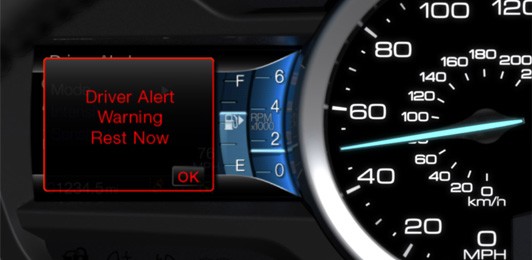Accident Avoidance and Driver Assist Technologies
A variety of Ford technologies, in addition to each vehicle’s handling and braking capabilities, can assist drivers by helping the driver control the vehicle or alerting the driver to potential risks. Also, these technologies can support everyday driving tasks by improving comfort and reducing demands on the driver.
Curve Control, for example, which launched on the 2011 Ford Explorer, is designed to sense when a driver is taking a curve too quickly. In those situations, it rapidly reduces engine torque and can apply four-wheel braking, slowing the vehicle by up to 10 mph in about a second. The technology is designed to be effective on wet or dry pavement, and is expected to be helpful when drivers are entering or exiting freeway ramps with too much speed. Curve Control will roll out in the majority of Ford products by 2015.
Ford’s Lane Keeping System consists of three elements to help a driver maintain proper lane position: Driver Alert, Lane Keeping Alert and Lane Keeping Aid. Using a small, forward-facing camera behind the inside rearview mirror, the system “looks” down the road, monitoring lane lines to determine that the vehicle is on course. Driver Alert computes a vigilance level for the driver and displays it in the instrument cluster upon request. The vigilance judgment is based on statistical analysis of lane information collected by the forward-looking camera and the vehicle’s yaw behavior. If the driver vigilance level falls below a certain level (i.e., if the driver gets tired), visual and audible warnings are given. Lane Keeping Alert is designed to warn the driver, via a vibration in the steering wheel and a warning chime, when the front-view camera detects that an unintentional lane departure is happening. Lane Keeping Aid goes a step further. It applies a steering torque in the direction the driver needs to steer to keep the vehicle in the current lane. If the front-view camera detects that a lane departure is still likely to occur, the system vibrates the steering wheel to help the driver recognize that additional action is needed.

Ford’s innovative Lane Keeping System
Lane Keeping System can be activated and deactivated manually via a switch on the turn indicator stalk or tuned to allow the driver to retain full steering control of the vehicle. The system is automatically deactivated at speeds below 38 mph, so as not to interfere in urban conditions when intentional lane crossing is relatively frequent. Lane Keeping Alert and Driver Alert were first available in Europe on the Ford Mondeo, S-MAX and Galaxy. The updated Lane Keeping System was introduced in Europe on the new Focus; it will be offered in North America on the 2013 Lincoln MKS, MKT and MKZ and the 2013 Ford Explorer and Fusion.
Ford’s Collision Warning with Brake Support technology activates a visual and audible warning when the system detects a high risk of collision with the vehicle in front. In addition, the brake system is pre-tensioned and the “servo boost” assistance system is modulated to provide faster brake performance (e.g., as soon as the driver lifts the gas pedal), if required by the driver. Range and speed information are sensed with long-range radar mounted on the front of the vehicle. Collision Warning with Brake Support can be activated or deactivated as the driver wishes. If the sensor becomes blocked by snow, ice or mud, the driver will receive a notice of reduced or suspended functionality. This technology is available in North America on the Ford Taurus, Edge and Explorer and the Lincoln MKS, MKX and MKT, and in Europe on the Ford Mondeo, S-MAX, Galaxy and Focus. The technology will also be available on the new 2013 Ford Fusion in North America.

Visual warnings from Ford’s Collision Warning with Brake Support technology
Finally, Ford’s industry-leading innovation known as AdvanceTrac® with Roll Stability Control® (RSC) continues to give drivers more driving confidence. RSC actively measures and helps control both yaw and roll movements. It uses two gyroscopic sensors to detect when a driver corners too fast or swerves sharply to avoid an obstacle. It then applies pressure to select brake(s) to help the driver maintain control, thus potentially reducing the risk of a rollover event.
Roll Stability Control is standard equipment on the Ford Flex, Explorer, Expedition, Edge, Escape and F-150, as well as E-Series wagons and vans and the 2011 SuperDuty with single rear-wheel configurations. It is also standard equipment on the Lincoln Navigator, MKX and MKT.
As of the 2012 calendar year, 100 percent of Ford vehicles (under 10,000 lbs. gross vehicle weight) in North America come standard with either RSC or our standard electronic stability control system.
Related Links
Vehicle Websites
- Ford Edge
- Ford Escape
- Ford Expedition
- Ford Explorer
- Ford E-Series
- Ford Flex
- Ford Fusion
- Ford Super Duty®
- Ford Taurus
- Ford F-150
- Lincoln MKS
- Lincoln MKT
- Lincoln MKX
- Lincoln MKZ
- Lincoln Navigator
